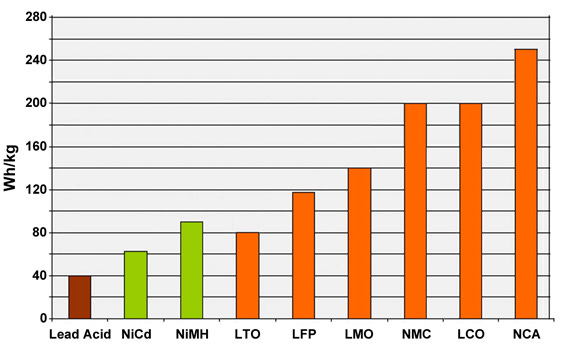Battery chemistries are rapidly developing with a focus on increasing energy density. Cathode active materials for Li-ion batteries typically consist of lithium metal oxides (LMO) which hold the energy to supply the electrochemical reaction. Some commercial Li-oxides are LCO, LFP, NCA, and NMC and are used in various applications depending on energy and stability needs. For this three part series I will focus on the chemistry, costs, and long term vision of the EV market.

Tesla became famous over the years, because they differentiated themselves by using cylindrical NCA (Lithium Nickel Cobalt Aluminum Oxide) batteries from Panasonic. These commercial batteries were then strung together in series to form a large module of over 6000 individual cells. Of all the commercially available active material chemistries, NCA provides the highest specific energy on a per cell basis as shown in the graph below below.

Other manufacturers focused on NMC (Li Nickel Manganese Cobalt Oxide) chemistries in pouch or prismatic cell formats. Extensive mechanical, electrical, and software engineering are necessary to maximize performance and safety of these batteries. Tesla’s unique focus enabled them to maintain a lead over the years, and they have continued to push the envelope by driving the industry to produce vehicles that have >300 mile range.
Per a report by Cars.com - these are the 2020 car models with the longest range.
1. 2020 Tesla Model S Long Range Plus: 402 miles
2. 2020 Tesla Model X Long Range Plus: 351 miles
3. 2020 Tesla Model 3 Long Range All-Wheel Drive: 322 miles
4. 2020 Tesla Model Y Long Range: 316 miles
5. 2020 Chevrolet Bolt EV: 259 miles
6. 2020 Hyundai Kona Electric: 258 miles
7. 2020 Kia Niro Electric: 239 miles
8. 2020 Jaguar I-Pace: 234 miles
9. 2020 Nissan Leaf Plus: 226 miles
10. 2020 Audi E-Tron: 204 miles
11. 2020 Porsche Taycan 4S: 203 miles
It is obvious that Tesla dominates the list. But, if Tesla has such a strong hold on the market why are there reports that they have been considering switching battery chemistry? In late May it was announced that Tesla filed with the Chinese government for approval to sell the model 3 with cheaper LFP cells. This suggests a drastic shift, because the specific energy of LFP is about half that of NCA.
LFP and NCA cells also have significantly different levels of stability. NCA is a more basic active material and in the presence of ambient air it will more readily react with water to form LiOH (lithium hydroxide). This LiOH can then react with other materials in electrode slurries and can contribute to slurry instability over time. For LFP and other active materials that have lower pH they are less susceptible to reacting with moisture, and therefore, more stable. Not only is this important for the electrode preparation process, it can also affect the electrochemical cell.
LFP batteries are much more stable and have a longer cycle life. They can also withstand higher charge and discharge currents which are necessary for the demands of the growing network of ultra fast charging stations. Here is a side-by-side comparison of the specifics for different active material chemistries per Journal of The Electrochemical Society, 164, (12) A2697-A2706 (2017).

One will see that LFP has a much lower nominal voltage, capacity, and energy density. This plays a significant role in how a battery pack can be designed for a specific use. Engineering and design improvements are needed to create an efficient battery to supply the needs of an EV.
A direct substitute with an NMC battery would suggest that it would be very difficult to attain a 300 mile range. I will detail more on cost and viability in future analysis.



